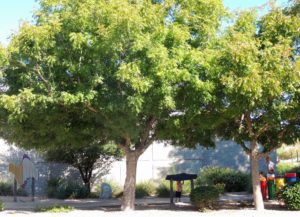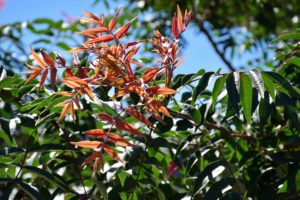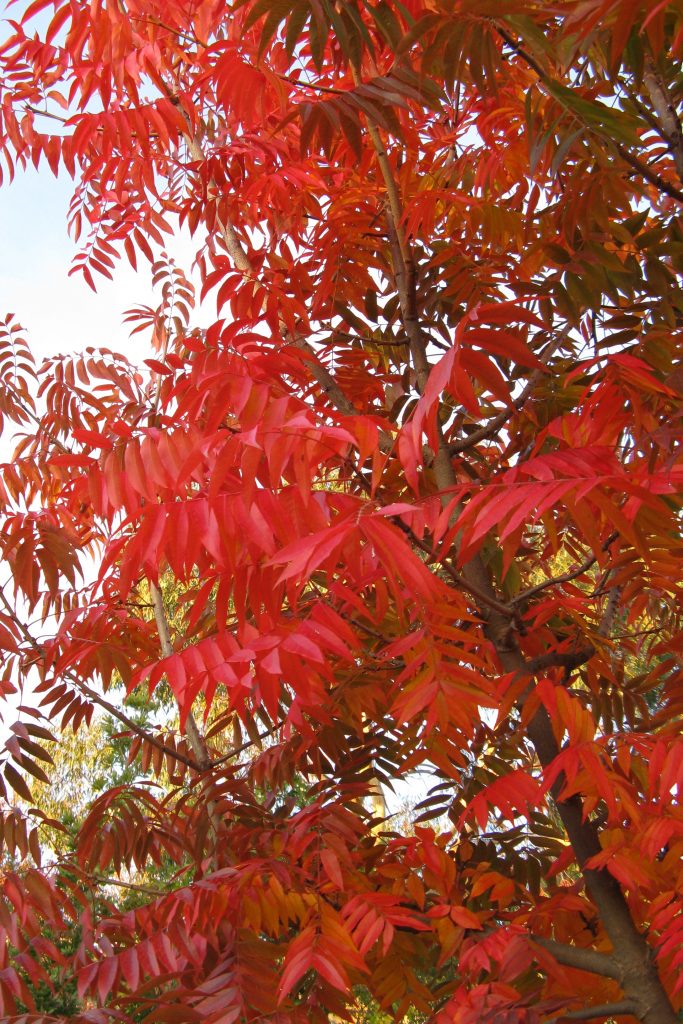Are you in search of the perfect tree? Try the Chinese Pistache (Pistacia chinensis). If you miss the vivid, light to very dark red, scarlet, orange and yellow colors of fall, this tree will give you a brilliant display in December, with new leaves emerging in late March to early April.
Chinese Pistache, a native to China and Taiwan, is a handsome ornamental hardwood shade tree with lustrous, finely-divided dark green leaves. It grows at a moderate rate to 25-40 feet tall and 25-30 feet wide. Young trees tend to be a bit awkward in appearance, but eventually become symmetrical, forming an upright oval, rounded shape. Older trees will develop interesting, deeply-fissured trunk bark.
The Chinese Pistache is a close relative of the pistachio nut tree. The wood is very hard and rot resistant. Young trees will probably need staking and grow slowly for the first three to five years after planting. Some careful structural pruning may also be necessary in the early years to develop an even canopy and proper branch spacing. Once they are established, they can grow two to three feet per year. This species has separate male and female trees (called dioecious). If you’re lucky to have a female, you’ll see clusters of half-inch red fruit. The fruit is non-edible for people but birds love them.


It’s not a fussy tree and will tolerate the alkaline soils and hot summers of the desert southwest. It is also hardy to minus 20 degrees F. Plant in full sun in deep soil that has good drainage. Allow the soil to dry on the surface between waterings to avoid soggy soil. Apply water once every 7 – 10 days during summer, then tapering to once a month in winter. Feed trees under 5 years old in the early spring with a nitrogen-based fertilizer.
The Versatility of the Chinese Pistache

A dependable tree for streets, desert landscapes, lawns or patios, with no serious disease problems, it is also pest resistant. It rarely requires pruning except to remove crossing, dead, or broken branches. Because this tree is deciduous in winter (it sheds its leaves), sunlight is able to warm the soil and any plants underneath.
There are several cultivars (selective breeding and cultivation creates a different variety) and hybrids with subtle unique accent features. Look for the cultivar ‘Sarah’s Radiance’ which is a clone and gives consistent red fall color. A related tree called the Red Push Pistache is a hybrid between Pistacia atlantica and Pistacia integerrima and does not produce nuts. New leaves have distinctive red color when they first emerge.
~ ~ ~ ~ ~ ~ ~ ~ ~ ~ ~ ~ ~ ~ ~ ~ ~ ~ ~ ~ ~ ~ ~ ~ ~
Did you know that up to 70 percent of water use is outdoors? That’s why we love desert plants and feature them each month. You can also learn more about plants on our Arizona Low-Water-Use Plants page. Visit our page on Choosing and Planting Low Water-Use Plants for tips on plant selection and how to plant properly. Also, be sure to read through all of our featured Plant of the Month blogs!
The City of Chandler Water Conservation Office is one of 19 Water – Use It Wisely partners to offer water-saving advice and programs.


